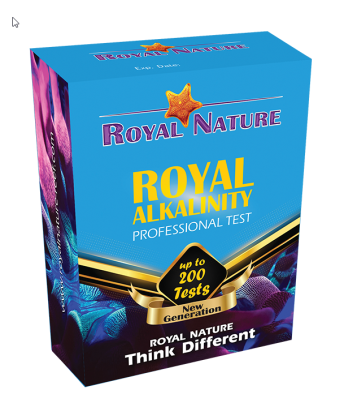Royal Nature
Royal Nature Alkalinity Professional Test
Royal Nature Alkalinity Professional Test
Couldn't load pickup availability
Test instructions - only 1 step
Each kit contains 200 tests.
1. Add 5 ml of aquarium water into the test tube using the 5 ml syringe.
Caution: Before using the test tube, make sure it is washed only with RO water and dry it with a soft paper.
Firmly attach the metal needle of the 1 ml syringe and draw in Alk-2 until the bottom of the black rubber end of the syringe is exactly at the 1.00 ml mark.
- Before this step, make sure that the needle does not contain any liquid and is submerged in water at all times to prevent air from entering the syringe.
- The presence of an air layer between the liquid and the black part of the syringe is normal and does not affect the result (the normal air layer you should see corresponds to 0.1 ml).
Add Alk-2 drop by drop to the test tube, swirling it gently after each drop. 3.
After 2-3 drops you will get a blue colored solution.
4) Continue adding Alk-2 to the test cuvette until the color turns yellow.
- There will be a brief green phase. The final result is achieved when the solution turns from green to yellow. When the solution is green, you are very close to the final result—approximately (1-2 drops).
Be aware that the yellow color will become lighter if you add more Alk-2 than necessary.
5.5. Note the position of the lower black part of the syringe (each division corresponds to 0.01 ml) and obtain the alkalinity result from the table. The reading should be taken at the position of the lower end of the black rubber part of the syringe.
The NSW alkalinity is around 7. Our recommendation is to keep the DKH values in the tank between: 7-10.
In case of low alkalinity, use Royal Sodium Bicarbonate in powder or liquid form to maintain parameters between: 7-10.
Alkalinity can be measured by titrating a sample with a strong acid until the entire buffering capacity of the above-mentioned ions, the pH of bicarbonate or carbonate, is consumed. This point is functionally set at pH 4.5.
At this point, all bases of interest have reached zero; they no longer cause alkalinity.
Alkalinity is usually expressed as CaCO3.
This can be converted into equivalents (dKH), where one equivalent is 17.848 mg/L.
Each test uses a two-part chemical reaction and a syringe. Unlike the Ca and Mg tests, the chemical solution is added to the seawater until the final color is achieved. We also guarantee that you will receive 200 tests with each dKH test.
In the Royal Nature Alkalinity Test, the correlation between the titration endpoint and the alkalinity value was calculated with numerous adjustments. Our ability to produce in small batches is crucial to achieving analytical calibration, which is a key to the accuracy of our test.

Caution! Corrosive. Keep out of reach of children!
Share


